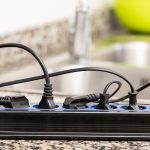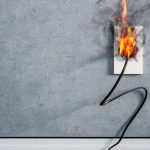Overloading an electrical circuit can cause some serious problems. While that may seem obvious, chances are that you’ve caused a circuit overload at least once in your life. The good news is that most modern homes are equipped to handle circuit overloads. In most cases, it will trip your circuit breaker and all you’ll have to do is flip it back on.
However, not all circuit overloads go as planned. Regardless of whether you have a modern circuit breaker in your home, you should always do your best to avoid a circuit overload. Read on to learn more about the dangers of an overloaded circuit and find out how you can prevent them.
An overloaded circuit is what happens when too much electrical demand is placed on a single circuit. For example, if you’re cooking and decide to use a toaster oven and an air fryer on the same outlet, you’ll probably overload your circuit.
It’s pretty easy to avoid circuit overloads like that, but they can strike even when you think you’re being safe. What’s most important is that you understand which outlets are on the same circuit and then distribute your high-consumption devices across those circuits.
While most people will experience only a brief power outage as a result of a circuit overload, worse problems can result. Some of the most notable dangers of a circuit overload include: fires, fried wiring, destroyed devices, shocks, and even electrocution.
Just because these issues are less common than they used to be doesn’t mean that they don’t happen. If you notice any signs of an impending overload, unplug your devices and consider moving some to a different circuit.
When you overload a circuit, it will likely be obvious. In most cases, it will shut off the power to a room in your home. To confirm that it was a circuit overload and not a power outage, check to see if the power is off in other rooms. You can also go to your electrical panel and see if the switch to the affected room is flipped to the off position. If it is, then you’ve overloaded the circuit and tripped the breaker.
In some cases, circuit overloads aren’t your fault. Sure, if you’re plugging five kitchen appliances into a single power strip, you’re definitely to blame, but that’s likely not the case. If you are using your outlets normally and still running into regular power issues, then your circuits are probably insufficient.
To overcome this, you should have a new circuit breaker installed. More powerful circuit breakers can deliver a better flow of electricity throughout your home. We have the expertise needed to replace your old circuit breaker. We can also check your wiring to make sure that your wires can keep up with the power demands of modern appliances and new technology. Give us a call today!





